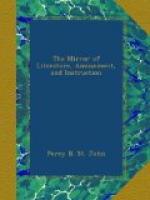He says, “I would desire the fair sex to consider how impossible it is for them to add any thing that can be ornamental to what is already the masterpiece of nature. The head has the most beautiful appearance, as well as the highest station, in a human figure. Nature has laid out all her art in beautifying the face; she has touched it with vermilion, planted in it a double row of ivory, made it the seat of smiles and blushes, lighted it up and enlivened it with the brightness of the eyes, hung it on each side with curious organs of sense, given it airs and graces that cannot be described, and surrounded it with such a flowing shade of hair as sets all its beauties in the most agreeable light. In short she seems to have designed the head as the cupola to the most glorious of her works; and when we load it with such a pile of supernumerary ornaments, we destroy the symmetry of the human figure, and foolishly contrive to call off the eye from great and real beauties to childish gew-gaws, ribbons, and bone-lace.”
Womankind, Mr. Editor, I do not believe, are naturally vain; but as they were made for us and for our comfort, it is natural that they should endeavour to gain our esteem; but they carry their endeavours too far; by straining to excite attention they overstep the mark, become vain and coquetish, one strives to outdo another, others say they must do as other women do, and they thus make themselves ridiculous unknowingly. It is really painful to see a woman of sense and education become a slave to the tyranny of fashion—and injuring both body and mind—and it is, I think, an insult to a man of understanding to endeavour to excite his attention by any such peculiarities.
Having now generally stated the subject that I should wish to be taken up by abler hands than mine, I will conclude by recommending all your town-bred, and coquetish ladies to study and restudy a letter signed “Mary Home,” in No. 254 of the excellent work before alluded to, “The Spectator.” —H. M—._Great Surrey Street, Aug. 1828_.
* * * * *
RETROSPECTIVE GLEANINGS
* * * * *
HISTORICAL ACCOUNT OF SMITHFIELD.
(For the Mirror.)
Stowe, in his “Survey of London,” 1633, says, “Then is Smithfield Pond, which of (old time) in records was called Horsepoole, for that men watered horses there, and was a great water. In the 6th of Henry V. a new building was made in the west part of Smithfield, betwixt the said poole and the river of Wels, or Turne-mill-brooke, in a place then called the Elms, for that there grew many elme-trees, and this had been the place of execution for offenders. Since the which time, the building there hath been so increased, that now remaineth not one tree growing. In the yeere 1357, the 31st of Edward III., great and royall justs were then holden in Smithfield, there being present the kings of England,




